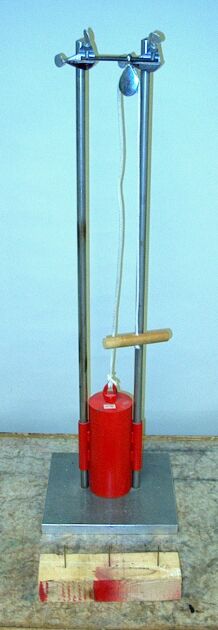

The pile driver in the photograph above comprises a 25-kg mass welded to sleeves that allow it to slide up and down on two vertical rods, and an overhead pulley with a handle and cord that allow you to raise and then drop the mass. You can raise the mass to a maximum height of 0.62 m above the base plate. The total height of the wood block and nails is about 0.11 m, so the maximum distance through which you can drop the mass is about 0.51 m.
The pile driver head starts from rest at its maximum height; it has zero kinetic energy. Gravity, acting over the distance of the drop, h, imparts kinetic energy to the head of (1/2)mv2 = mgh. Here, we are neglecting friction on the rods and in the pulley system. If we knew the magnitude of the friction, we would subtract it from mg, then multiply that result by h to obtain the total work done on the head as it falls. If we wish, we can calculate the final speed of the driver head just as it hits the top of the nail; it is √(2gh) (or, with friction taken into account, √(2Wtotal/m)). When the head meets the nail, the nail acts upon it with an upward force, n, which acts until either the head comes to rest, or the nail is driven all the way into the block and either the block or the base plate (via the nail) does the additional work necessary to stop the driver head.
If you drop the head from the maximum height, it drives the nail completely through the block. The nail is slightly longer than the thickness of the block, so the head protrudes, and the top of the nail bends a bit. So the work done in merely driving the nail through the block is not quite enough to stop the driver head. In case the additional work done in bending the nail is small, we can calculate a maximum estimate of the force with which the nail acts on the driver head as it goes into the block. In going all the way into the block, the nail is driven approximately 0.053 m. The downward force on the head is (25 kg)(9.8 m/s2), or 245 N, and the total work done during the nail driving is (245 N)(0.053 m) - n(0.053 m), where n is the upward, or normal, force of the nail acting on the head, and the minus sign is to account for the direction. This work equals the change in kinetic energy during the nail driving. The kinetic energy when the driver head hits the nail is (25 kg)(9.8 m/s2)(0.51 m), or 125 J, and afterwards, it is zero, so the change is -125 J. So -125 J = (245 N)(0.053 m) - n(0.053 m), or n = 2,600 N.
A better example, however, is when the nail does not go all the way into the block. If you drop the head from 0.37 m, this gives a drop distance of 0.26 m, and the nail goes about 0.036 m into the block. In this case, the kinetic energy change during the nail driving is -(25 kg)(9.8 m/s2)(0.26 m), or -64 J, and we have -64 J = (245 N)(0.036 m) - n(0.036 m), or n = 2,000 N. In these two examples, we have assumed that n, the normal force of the nail against the driver head, is constant.
The principle behind the pile driver, or any kind of hammer, is that a relatively small force does positive work over a relatively large distance, to counter a much larger force that does negative work over a much smaller distance. If you rest the driver head on the nail, or, similarly, if you try to push a nail into a board by setting a hammer on top of it and pushing, the head just rests on the nail and cannot move it; the force required is much more than gravity, or you, can provide. If you drop the pile driver head from a significant distance, though, or swing the hammer through a long arc, gravity, or your arm, can perform enough work on the head that it takes some distance for the much larger force exerted by the nail to stop it. That distance is how far you drive the nail into the board. This is also why it is so painful if you accidentally hit your thumb with a hammer. Your thumb has to provide a large force to stop the hammer head, and it suffers deformation over the distance it takes for the hammer head to come to rest.
References:
1) Young, Hugh D. and Geller, Robert M. Sears and Zemansky’s College Physics, 8th edition (San Francisco: Addison Wesley, 2007), pp. 199-200.